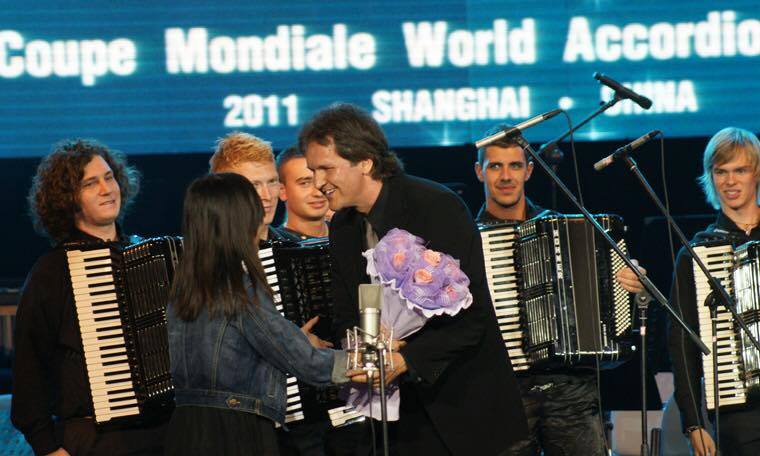Andreas Nebl: curiosità e innovazione per crescere artisticamente
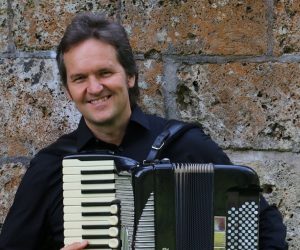 Fisarmonicista e musicista a tutto tondo, dalla visione artistica a 360 gradi, sempre propenso a sperimentare svariati generi musicali, Andreas Nebl racconta la sua vita professionale, ricca di interessantissimi aneddoti, attraverso questa ricca intervista.
Fisarmonicista e musicista a tutto tondo, dalla visione artistica a 360 gradi, sempre propenso a sperimentare svariati generi musicali, Andreas Nebl racconta la sua vita professionale, ricca di interessantissimi aneddoti, attraverso questa ricca intervista.
Ti sei forgiato musicalmente agli inizi della tua carriera con la musica folk e il jazz, per poi frequentare i corsi presso l’Università Statale di Musica di Trossingen con il Prof. Hugo Noth e al “Luigi Cherubini” di Firenze con Ivano Battiston. Attualmente, in aggiunta alla tua professione di insegnante di cui parleremo successivamente, hai spostato la tua attenzione sulla musica da camera e sulla musica antica. In quale genere ti riconosci prevalentemente?
«Oggi mi vedo principalmente come musicista da camera. Suonare con altri strumentisti e cantanti è per me l’esperienza artistica più bella e più ricca che si possa vivere. Al momento, ho anche un progetto solistico. Inizierò una produzione di CD con venti sonate di Domenico Scarlatti nell’estate 2020».
Questa varietà di generi che hai sperimentato nel corso degli anni credi possa contribuire a completare, a perfezionare il tuo percorso formativo? In sintesi, il consiglio che dai ai tuoi allievi è quello di provare strade diverse oppure ritieni sia più opportuno fare una scelta definitiva e lavorare in funzione di quella?
«Sono stato fortunato nel conoscere persone culturalmente molto diverse, come miei amici in diverse fasi della vita. E, indipendentemente dal fatto che fossi con musicisti folk, appassionati di jazz, amanti della fisarmonica, musicisti classici, artisti d’avanguardia, ho avuto l’opportunità di conoscere persone appartenenti ad ogni gruppo culturale, che, con grande amore ed emotività, hanno trovato un legame tra la propria musica e la vita personale. Da un punto di vista musicale, ho incontrato qualità e fenomeni in molti stili diversi. Posso riconoscere circa cinquanta differenti gruppi di musica slovena dell’Alta Carniola solo dal loro suono. Inoltre, non dimenticherò mai la grande libertà che ho sperimentato e il “timing” assoluto e incorruttibile di alcuni amici musicisti jazz, così come l’estetica dei pianisti dei miei primi anni, o la bellezza del timbro del clarinetto di mio fratello quando ho avuto occasione di suonarlo. Al pianoforte, da adolescente, per esempio, ho accompagnato un concerto di Mozart. Da bambino, ho osservato le persone anziane nella nostra cerchia di conoscenti, che avevano le lacrime agli occhi a causa di alcune “costellazioni sonore” nella musica degli ottoni boemi. Anche questo mi ha plasmato profondamente. Cerco queste forme molto diverse di amore per la musica, questa ricchezza di stati di connessione assoluta con ogni nuova musica che mi viene incontro. Le lezioni scolastiche, tuttavia, non possono sostituirsi alla vita. Nell’insegnamento sei impegnato in una sorta di “protocollo”: in linea di principio insegno in ambito “classico”, perché credo di poter trasmettere di più in questo campo. Naturalmente, quando gli studenti mi avvicinano direttamente, sia che io faccia improvvisazione jazz o altre cose stilistiche con loro, non dico mai no. È molto importante che ognuno intraprenda e percorra la propria strada. Spesso il tutto coincide perfettamente anche con la vita personale».
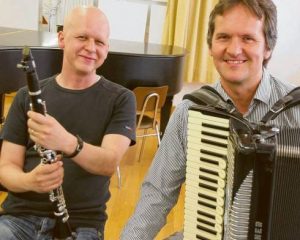 Cosa intendi per musica antica? Ti riferisci al periodo a cavallo tra il Medioevo e il Rinascimento? Quali sono i compositori, relativi a quel periodo, che prediligi e quali opere si prestano maggiormente alla trascrizione per fisarmonica?
Cosa intendi per musica antica? Ti riferisci al periodo a cavallo tra il Medioevo e il Rinascimento? Quali sono i compositori, relativi a quel periodo, che prediligi e quali opere si prestano maggiormente alla trascrizione per fisarmonica?
«Con musica antica, nell’area di lingua tedesca, s’intende prima di tutto Bach. Per me, Johann Sebastian Bach è ovviamente il grande maestro e rappresentante della musica barocca per tastiera. E lo sono anche Domenico Scarlatti, Händel, Couperin, Rameau, Frescobaldi, Froberger e molti altri. In questa cerchia di compositori, molti brani sono sicuramente adatti alla trascrizione per fisarmonica. Scarlatti fa da tempo parte della formazione di base di ogni corso di fisarmonica. Con questo compositore in particolare, tra i fisarmonicisti sono emerse alcune norme sull’interpretazione. A mio avviso, il colore intrinsecamente affascinante di questi gioielli richiede approcci interpretativi molto più nuovi e propri. A volte, prima ancora di eseguirle con la fisarmonica, penso che Scarlatti, anziché aver composto queste sonate per clavicembalo, le abbia create per quartetto d’archi o quintetto di fiati. L’idea di una strumentazione immaginaria gioca un ruolo importante nella mia attuale preparazione per il CD Scarlatti. Quando mi esercito e suono, nella mia immaginazione una versione orchestrata corre in parallelo per quasi tutte le sonate. Questo porta con sé molte nuove idee e colori molto eccitanti e richiede un grande sforzo da parte mia, in parte per fare estreme differenze in termini di articolazione e dinamica, ma anche per rendere le mani indipendenti dal mantice o all’interno di una mano».
Dalla musica antica alla musica contemporanea. Ci sono in Germania compositori che creano musica originale per fisarmonica? E più in generale, cosa pensi dei nuovi linguaggi che coinvolgono anche il nostro strumento ad ancia?
«In Germania esiste una linea molto affascinante nel campo della fisarmonica per quanto riguarda i più importanti compositori. Hans Brehme, Wolfgang Jacobi, Jaime Padros (un catalano che vive in Germania e che ha lavorato molto con Hugo Noth), Georg Katzer, Toshio Hosokawa (un giapponese con una grande affinità con la Germania), Sofia Gubaidulina (com’è noto, una compositrice russa che vive in Germania), Nicolaus A. Huber e Klaus Huber sono sicuramente tra i rappresentanti più importanti. Il linguaggio della musica contemporanea è una parte molto importante della nostra vita culturale. Fortunatamente, qui vengono ancora ricercate nuove soluzioni e vengono condotti esperimenti. Pezzi come Melodia di Toshio Hosokawa, Jeux d ́anches di Magnus Lindberg, On Wings of the Harp di Nikolaus A. Huber saranno sicuramente considerate pietre miliari nell’arte della fisarmonica tra cinquant’anni. Altri brani didattici che sono ancora molto eseguiti saranno sicuramente dimenticati. Dobbiamo renderci conto che la cultura della fisarmonica deve attraversare due o tre generazioni in termini di sensibilità estetica prima di capire perché l’arte contemporanea è così preziosa. Di recente, ho ascoltato il famoso quartetto d’archi Ebène eseguire un programma che vedeva Beethoven a confronto con un’opera di un compositore francese contemporaneo recentemente scomparso, ossia Dutilleux. È stato un evento musicale emozionante. La sala nella Liederhalle di Stoccarda era piena e il pubblico era entusiasta del pezzo di Dutilleux come lo era dei quartetti di Beethoven».
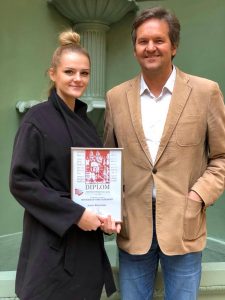 In Germania, più che in altri stati europei ed extra continentali, ci sono un gran numero di fisorchestre e comunque di formazioni, anche ridotte, la cui peculiarità e quelle di inglobare più fisarmonicisti. È una tradizione che si rinnova da anni oppure è un fenomeno dovuto alla “rivalutazione” dello strumento?
In Germania, più che in altri stati europei ed extra continentali, ci sono un gran numero di fisorchestre e comunque di formazioni, anche ridotte, la cui peculiarità e quelle di inglobare più fisarmonicisti. È una tradizione che si rinnova da anni oppure è un fenomeno dovuto alla “rivalutazione” dello strumento?
«Il fenomeno dell’orchestra di fisarmoniche era originariamente noto per essere un ensemble a carattere didattico. In linea di principio, in nessun momento c’erano compositori che, per ragioni estetiche o di curiosità, avrebbero scritto per questa speciale combinazione degli stessi strumenti. Molti compositori lavorano professionalmente per assicurare l’esistenza di un repertorio utile alla dimensione sociale ed educativa. Ora sono state prodotte alcune composizioni che trovo piuttosto interessanti. Ad esempio, Unter den Himmeln di Peter Hoch, Colours di Slavko Suklar o In F di Antun Dolicki sono pezzi molto espressivi che incorporano nella musica le peculiarità e le caratteristiche immediate del suono dell’orchestra di fisarmoniche. Io stesso ho avuto esperienze come direttore di un organico così “utile” durante i miei studi. La creazione di un suono trasparente da venticinque strumenti identici è stata davvero una sfida entusiasmante. Ci sono, per esempio, anche orchestre di clarinetti o di flauti. Da un punto di vista educativo, per molte scuole di musica si tratta di orchestre ugualmente molto prolifiche per quanto riguarda l’interazione o altri aspetti sociali».
Sei il docente di fisarmonica dell’Akkordeon an der Musikhochschule di Norimberga e hai tenuto corsi di perfezionamento in mezzo mondo tra cui al Conservatorio centrale di musica di Pechino, presso la Gnessin Academy di Mosca, l’Accademia di Lodz, l’Università di Kaunas, il Conservatorio di Trieste, il Conservatorio di Praga e l’Istituto Goethe di Bogotà. Come valuti il movimento fisarmonicistico a livello internazionale? Quali sono le scuole, intese come “movimento culturale”, che prediligi?
«La scuola di Hugo Noth, da cui sono emerse persone brillanti come Stefan Hussong, Teodoro Anzellotti, Mie Miki e molti altri strumentisti nonché insegnanti delle università tedesche ed europee, è ancora la più importante per me in termini di estetica della fisarmonica. Nutro anche un grande rispetto per le scuole fondate da Friedrich Lips, Matti Rantanen, il defunto Mogens Ellegaard e Cao Xiaoqing in Cina. Sono anche molto contento di artisti come Ksenja Sidorova o Martynas Levickis, che fanno un ottimo lavoro, utile a tutti noi per rendere popolare la musica classica sulla fisarmonica. Il problema del movimento internazionale della fisarmonica nel suo insieme è, a mio avviso, che non ha ancora trovato una propria identità, tranne che nel genere contemporaneo. Molti musicisti si esprimono tecnicamente ad un livello notevole, ma raramente si sente un’affermazione duratura riguardo alla propria consacrazione artistica, o una particolare raffinatezza per un suono vincolante. Un amico violinista mi ha insegnato molto sull’estetica. Quando abbiamo suonato insieme una sonata di Mozart per violino, ha detto: ‘Questo crescendo è davvero meraviglioso mentre lo suoni. Ma se fai solo un po’ di più, sembrerebbe un marinaio’ (n.d.t. tipico modo di dire in ambiente fisarmonicistico relativo ad un uso sproporzionato del mantice). Dobbiamo assolutamente sviluppare questa cultura dell’ascolto con attenzione. Anche i concertisti più famosi, a volte, lanciano messaggi controversi e non si fanno davvero un favore poiché dimostrano che le loro orecchie non sono realmente allenate in modo naturale, se non, addirittura, deformate da abitudini musicali da fast food o da pensiero tecnocratico».
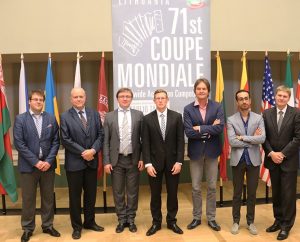 Com’è, invece, la situazione della fisarmonica nel tuo paese di origine?
Com’è, invece, la situazione della fisarmonica nel tuo paese di origine?
«In Germania, scuole e club di musica sono preoccupati per la diminuzione del numero degli allievi. Tuttavia, se osservi con maggiore attenzione, ci sono numeri di studenti molto stabili nei luoghi in cui lavorano personalità forti e ci sono sempre liste di attesa. Gli insegnanti di successo delle scuole di musica che conosco operano in maniera diversa. Rappresentano la fisarmonica con grande sicurezza, sono personalità autentiche. Stanno ancora formando strumentisti e hanno un buon contatto con i genitori degli studenti. Oltre alle lezioni, svolgono regolarmente altre attività con i giovani, come audizioni, concerti o concorsi. E lavorano più di quanto non vengano pagati».
Come docente di giuria hai presenziato i più importanti concorsi internazionali e ti abbiamo visto anche più volte al PIF di Castelfidardo. Cosa ne pensi della scuola e della tradizione italiana?
«In Italia ci sono tradizionalmente molti musicisti di talento. Ivano Battiston, Giorgio Dellarole, Corrado Rojac e Simone Zanchini sono particolarmente impressionanti tra gli attuali fisarmonicisti. Ivano Battiston era il mio insegnante a Firenze, lo conosco principalmente come musicista da camera con colori molto rari: trovo infatti i suoi colori nella dinamica “piano” molto interessanti. Giorgio Dellarole è noto per essere un pioniere molto serio nell’affrontare la pratica della “musica antica”. Corrado Rojac è un musicista colto estremamente versatile, con cui amo parlare. Abbiamo fatto una passeggiata molto lunga a Trieste in occasione di una master class, durante la quale abbiamo trattato tanti argomenti interessanti: filosofia, storia, pittura, estetica e, ovviamente, anche musica. Ho ammirato l’estro improvvisativo e il virtuosismo di Simone Zanchini quando ha suonato in Colombia, dove siamo stati entrambi invitati dal Goethe Institute nel 2017. A mio avviso, Patrizia Angeloni, per esempio, è una didatta di grande talento. Karl Huber di Bolzano e Antonio Spaccarotella sono sicuramente personaggi e insegnanti molto interessanti. E da non dimenticare il talentuoso Mirko Patarini, noto per combinare intelligenze molto diverse come artista, costruttore di strumenti e uomo d’affari. E, naturalmente, ci sono molti altri musicisti e docenti dotati in questo meraviglioso Paese di musica e canto, che non posso elencare ora».
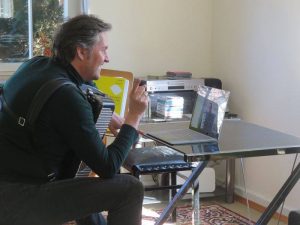 Quali sono i tuoi compositori preferiti e quali sono, a tuo parere, i migliori interpreti in Germania e, più in generale, nel mondo intero?
Quali sono i tuoi compositori preferiti e quali sono, a tuo parere, i migliori interpreti in Germania e, più in generale, nel mondo intero?
«I miei compositori preferiti in generale sono Bach, Haydn, Mozart, Brahms, Stravinsky, Cage e Stockhausen. Il genere del quartetto d’archi è una costante fonte d’ispirazione per una mia personale espansione dell’orizzonte musicale. Ho avuto l’opportunità di vedere molti famosi quartetti d’archi come “Quartetto Artemis”, il “Quartetto Hagen”, il “Quartetto Ebène”, il “Quartetto Belcea”, il “Quartetto Emerson”, il “Quartetto Mandelring”, il “Melos Quartet”, gli “Arditti Quartet”, il “Casals Quartet”, il “Lotus Quartet”, il “Jerusalem Quartet”, il “Vogler Quartet”, il “Tokyo String Quartet” tutti ascoltati dal vivo in concerti. Ognuno di questi concerti è diventato per me un evento importante nel tempo. A mio avviso, i più considerevoli interpreti della fisarmonica in Germania sono Teodoro Anzellotti, Stefan Hussong e Mie Miki, sono rimasto molto colpito da Inaki Alberdi, Luka Juhart, Hans Maier, Xu Xiaonan, Fanny Vicens e Sergej Osokin in tutto il mondo».
C’è un giovane emergente sul quale scommetteresti per il prossimo futuro?
«Ci sono giovani strumentisti interessanti, senza dubbio. Sono molto cauto quando si tratta di fare previsioni, perché la vita, specialmente se si deve assumersene la responsabilità, ad un certo punto può spesso portare a svolte impreviste. Il podio pubblico di talentuosi fisarmonicisti è principalmente un “circo “ fatto di concorrenza. Tuttavia, questo ambiente, a volte, richiede requisiti completamente diversi rispetto alla vita musicale attuale. Mentre nelle competizioni la sicurezza e la padronanza tecnica sono viste come la base, a mio avviso la creatività, la sensibilità, l’apertura, il coraggio di rischiare e quello di pensare in modo diverso sono caratteristiche molto importanti nella vita musicale reale, i requisiti primari per il successo artistico».
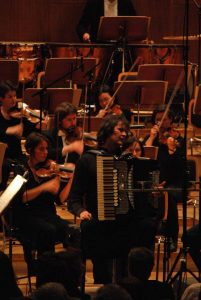 Hai tenuto concerti in quasi tutti i paesi dell’UE, oltre a Russia, Giappone, Corea, Cina, Stati Uniti, Argentina e Colombia. Dove i prossimi impegni?
Hai tenuto concerti in quasi tutti i paesi dell’UE, oltre a Russia, Giappone, Corea, Cina, Stati Uniti, Argentina e Colombia. Dove i prossimi impegni?
«Ai tempi dell’attuale crisi del coronavirus, così come per tanti colleghi, un’intera serie di concerti e masterclass sono stati cancellati. Non vedo l’ora di fare una visita a Pechino con mia moglie, Naoko Takeuchi (campionessa mondiale di armonica e concertista molto attiva) dove Cao Xiaoqing ha avuto l’idea di un evento in cui Sheng, fisarmonica e armonica siano connessi. Un tour di concerti in Giappone è previsto per l’inizio del 2021. All’inizio del 2020, un gruppo di coreani è venuto in Germania per una settimana di lezioni. Molto probabilmente, andrò in Corea per concerti e una master class. Inoltre, sono in programma numerosi appuntamenti con il duo “Nebl & Nebl”, tour con i miei studenti in Italia e in Lituania, impegni in giurie di concorsi internazionali, il mio insegnamento all’Università della Musica di Norimberga, al Conservatorio di Trossingen, corsi nazionali e internazionali; infine, la mia partecipazione al “CIA Music Commettee” e molto altro».
Il prossimo anno la vostra associazione DHV festeggerà l’anniversario della fondazione con l’organizzazione della Coupe Mondiale (CIA). Puoi darci qualche anteprima in esclusiva?
«La Coupe Mondiale 2021 in Germania si terrà dall’11 al 17 Ottobre a Monaco di Baviera. Sono in programma un concerto di apertura e uno di chiusura, nei quali i punti di forza e le caratteristiche speciali di questa associazione (musica da camera, armonica e orchestra di fisarmoniche) svolgeranno un ruolo rilevante. Le competizioni musicali d’intrattenimento si terranno in concerti serali pubblici. Lo svolgimento della Coupe Mondiale coincide con il 90° anniversario della fondazione della storica associazione tedesca DHV e, quindi, ci aspettiamo che molte personalità della vita pubblica, della politica e della cultura partecipino a questo grande evento».
————————————————————————————
Andreas Nebl: curiosity and innovation to grow artistically
 Accordionist and great musician, always inclined to experiment with various musical genres, Andreas Nebl tells his professional life, full of interesting anecdotes, through this amazing interview.
Accordionist and great musician, always inclined to experiment with various musical genres, Andreas Nebl tells his professional life, full of interesting anecdotes, through this amazing interview.
At the beginning of your career, your musical training was based on folk music and jazz, and then you attended courses at the State University of Music in Trossingen with Prof. Hugo Noth, later at the “Luigi Cherubini” in Florence with Ivano Battiston. Currently, in addition to your teaching profession, which we will discuss later, you have shifted your focus to Chamber music and Early Music. Which genre is more suitable for you?
Today I see myself primarily as a chamber musician. Playing with other instrumentalists and singers is the most beautiful and richest experience in music for me. At the moment I also have a solo focus. I will start a CD production with 20 sonatas by Domenico Scarlatti in summer 2020.
A variety of genres that you have experienced over the years: do you think they can help to improve and complete your training? In other words, the advice you give to your students is to try all musical paths or do you think it is more appropriate to make a choice and work according to that?
I was lucky to be able to see very different cultural people as my friends in different phases of life. Regardless of whether it was or is with folk musicians, jazz freaks, accordion fetishists, classical musicians, avant-garde artists – I was able to get to know people in every cultural group who, with great love and the greatest emotional devotion, found a match for their personal emotional life in their music. From a musical point of view, I was able to get to know very different qualities and phenomena in many styles. I can still recognize about fifty different groups of Slovenian Upper Carniolan music by their sound. I will also never forget the great freedom I experienced and the absolute, incorruptible timing of some friends of jazz musicians when I played music, as well as the aesthetics of pianists from my early years, or the beauty of the tone of my brother’s clarinet when I played him on the piano as a teenager for example accompanied the Mozart concert. As a child, I was allowed to observe older people in our circle of acquaintances, who got tears in their eyes due to certain sonic constellations in Bohemian brass music. That also shaped me deeply. I look for these very diverse forms of love for music, this wealth of states of absolute connection with every new music that comes my way.
As a music school or as a teacher, however, life cannot be replaced. You have to get involved with forms when teaching. In principle I teach very classically because I believe that I can convey the most in this field. Of course, when students approach me directly, whether I do jazz improvisation or other stylistic things with them, I don’t say no. – It is very important that everyone goes their own way. Often it has to do with coincidences where you are going.
 What do you mean by Early Music? Are you referring to the period between the Middle Ages and the Renaissance? Which composers, related to that period, do you prefer and which works are best suited to the transcription for accordion?
What do you mean by Early Music? Are you referring to the period between the Middle Ages and the Renaissance? Which composers, related to that period, do you prefer and which works are best suited to the transcription for accordion?
With “Early Music” in the German-speaking area is the time before J.S. Bach meant. For me, like many others, Johann Sebastian Bach is, of course, the great master and representative of baroque keyboard music. Also Domenico Scarlatti, Handel, Couperin, Rameau, Frescobaldi, Froberger, and many others. From this circle of composers, many pieces are surely suitable as transcriptions for accordion. Scarlatti has long been part of the basic training of every accordion course. With this composer in particular, certain standardizations regarding interpretation have emerged among accordionists. In my view, the intrinsically fascinating color of these so many pieces of jewelry requires much more new, own approaches to interpretation. Sometimes I think that you set up these sonatas for string quartet or woodwind quintet before playing them on the accordion. The idea of “imaginary instrumentation” plays a major role in my current preparation for the Scarlatti CD. When practicing and playing, in my imagination an orchestrated version runs in parallel for almost every sonata. This brings with it a lot of new ideas and very exciting colors, and requires a great deal of effort from myself, in some cases extreme differentiations in terms of articulation and dynamics, but also in the independence of the hands from the bellows or within one hand.
From Early Music to Contemporary Music. Are there German contemporary composers involved in music for accordion? And more generally, what do you think about new languages that also involve our “reed instrument”?
In Germany there is a very exciting line in the accordion area with regard to the most important composers. Hans Brehme, Wolfgang Jacobi, Jaime Padros (a Catalan living in Germany who had worked a lot with Hugo Noth), Georg Katzer, Toshio Hosokawa (as is well known, a Japanese man with a great affinity for Germany), Sofia Gubaidulina (as is well known, a Russian woman living in Germany ), Nicolaus A. Huber and Klaus Huber are certainly among the most important representatives. The language of contemporary music is a very important part of our cultural life. Fortunately, new things are still being searched for here and experiments are being carried out. Pieces like “Melodia” by Toshio Hosokawa, “Jeux d´anches” by Magnus Lindberg, “On Wings of the Harp” by Nikolaus A. Huber will definitely be considered milestones in accordion art in fifty years. Other educational pieces that are still very much played at the moment will certainly be forgotten. We have to realize that accordion culture has to go through two or three dimensions in terms of aesthetic sensitivity before it can understand why contemporary art is so valuable. I recently heard the famous Ebène string quartet with a Beethoven program, which they contrasted with a work by the recently deceased contemporary French composer Dutilleux. As a musical event, that evening was at least as exciting as the two framing Beethoven quartets. The hall in the Stuttgart Liederhalle was packed and the audience was as enthusiastic about Dutilleux’s piece as it was about the Beethoven quartets.
 In Germany, more than in other European and extra-continental states, there are a large number of accordion orchestra and ensembles that include several accordion players. Is this a tradition that has been renewed for years or is it a phenomenon due to the “revaluation” of the instrument?
In Germany, more than in other European and extra-continental states, there are a large number of accordion orchestra and ensembles that include several accordion players. Is this a tradition that has been renewed for years or is it a phenomenon due to the “revaluation” of the instrument?
The phenomenon of the accordion orchestra was originally known to be a company or an educational idea. In principle, at no time there were composers who, for aesthetic reasons or motivations of curiosity, would have composed for this special combination of the same instruments. All composers were commissioned and some of them still earn their money to ensure social or educational work in the lay movement, which is perfectly fine. There are now some compositions that I find quite interesting. E.g. “Unter den Himmeln” by Peter Hoch, “Colors” by Slavko Suklar or “In F” by Antun Dolicki are very expressive pieces that incorporate the immediate peculiarities or peculiarities of the accordion orchestra sound into the music. I myself had experiences as a conductor of such a group during my studies. Shaping a transparent sound from 25 identical instruments was indeed an exciting challenge. There are e.g. also clarinet orchestra or flute orchestra. From an educational point of view, for many music schools these are equally very profitable orchestras with regard to the interplay or other social aspects.
You are professor of accordion at the Hochschule für Musik in Nuremberg and you have held master classes all over the world including at the Central Conservatory of Music in Beijing, at the Gnessin Academy in Moscow, the Academy of Lodz, the University of Kaunas, the Conservatory of Trieste, the Conservatory of Prague and the Goethe Institute of Bogota. How do you evaluate the accordion movement at an international level? Which are the schools, understood as ‘cultural movement’ that do you prefer?
Hugo Noth’s school, from which brilliant players and teachers at German and European universities emerged, is still the most important for me in terms of aesthetics at the accordion Scale. I also have great respect for the schools founded by Friedrich Lips, Matti Rantanen, Mogens Ellegaard, and Cao Xiaoqing in China. I am also very happy about such active performers as Ksenja Sidorova or Martynas Levickis, who get involved in the company and do a great job for all of us to make classical music on the accordion popular.
The problem of the international accordion movement as a whole is, in my view, that it has not yet found a really binding identity – except in the contemporary field. Many of them play technically at a remarkable level, but you rarely hear a lasting statement regarding your own artistic statement, or a special sophistication for a binding sound. A violinist friend taught me a lot about aesthetics. When we played a Mozart violin sonata together, he said: “This crescendo is really wonderful as you play it. But if you only give a little more, it would sound like a sailor! ”We definitely need to develop this culture of listening carefully. Because even more well-known players sometimes send dubious messages and really don’t do themselves a favor with these “generous” statements, because they reveal that their ears are not really naturally trained, or even deformed by musical fast-food habits or technocratic thinking is.
 How is the accordion situation in your home country?
How is the accordion situation in your home country?
In Germany, music schools and clubs have been worrying about declining student numbers for years. However, if you take a closer look, there are actually very stable student numbers in the places where strong personalities work and there are always waiting lists. The successful music school teachers I know combine several things. They represent the instrument accordion with great self-confidence. They are authentic personalities in their appearance. They are all still practicing players. You have good contact with the parents of the students. In addition to the lessons, they regularly do activities with the students, such as auditions, concerts or competitions. And: they work more than they get paid immediately.
As a professor of jury you attended the most important international competitions and we have seen your several times at the PIF in Castelfidardo. What do you think about the Italian school and tradition?
In Italy there are traditionally many talented singers and musicians. Ivano Battiston, Giorgio Dellarole, Corrado Rojac and Simone Zanchini are particularly impressive among the current accordionists. Ivano Battiston was my teacher in Florence, I know him mainly as a chamber musician with very rarely heard fantastic colors in the piano field. Giorgio Dellarole is known to be a very serious pioneer in dealing with the “old music” practice. Corrado Rojac is an enormously versatile educated musician, with whom I love to talk. We had a very long walk in Trieste on the occasion of a master class, where we found exciting things in various topics, philosophy, history, painting, aesthetics and of course also in music. I admired Simone Zanchini’s spontaneous and virtuoso art of playing in Colombia, where we were both invited together by the Goethe Institute there in 2017. In my view, Patrizia Angeloni, for example, is a very talented educator. Karl Huber from Bolzano and Antonio Spaccarotella are certainly very interesting personalities and teachers. And not to be forgotten: the multi-talented Mirko Patarini, who is known to combine very different intelligences as an artist, instrument maker and businessman. And, of course, there are many other talented musicians and educators in this wonderful country of music and singing that I cannot list now.
 Which are your favorite composers and which are, in your opinion, the best performers in Germany and, more generally, in the whole world?
Which are your favorite composers and which are, in your opinion, the best performers in Germany and, more generally, in the whole world?
My favorite composers in general are Bach, Haydn, Mozart, Brahms, Stravinsky, Cage and Stockhausen. The genre of the string quartet is a constant inspiration for my personal expansion of the musical horizon. I had the opportunity to see many famous string quartets such as the “Artemis Quartet”, the “Hagen Quartet”, the “Ebène Quartet”, the “Belcea Quartet”, the “Emerson Quartet”, the “Mandelring Quartet”, the “Melos Quartet”, the “Arditti Quartet”, the “Casals Quartet”, the “Lotus Quartet”, the “Jerusalem Quartet”, the “Vogler Quartet”, the “Tokyo String Quartet” all heard live in concerts. Each of these concerts became a sustainable event for me. In my view, the most important interpreters of the accordion in Germany are Teodoro Anzellotti, Stefan Hussong and Mie Miki, all over the world I am very impressed by Inaki Alberdi, Luka Juhart, Hans Maier, Xu Xiaonan, Fanny Vicens and Sergej Osokin.
Is there an emerging young player you’d bet on for the foreseeable future?
There are interesting young players, without a doubt. I am very careful with forecasts because life, especially if you have to take responsibility for it at some point, can very often bring about unforeseen turning points. The public podium of talented accordionists is primarily the competition circus. However, this environment sometimes requires completely different requirements than the actual musical life. While in competitions safety and technical mastery are seen as the basis, in my view strengths such as creativity, sensitivity, openness, courage to take risks and the courage to think differently are very important characteristics in real music life, which are among the primary requirements for artistic success.
 You have given concerts in almost all EU countries, as well as Russia, Japan, Korea, China, the United States, Argentina and Colombia. Where are your next engagements?
You have given concerts in almost all EU countries, as well as Russia, Japan, Korea, China, the United States, Argentina and Colombia. Where are your next engagements?
In the times of the current corona crisis, as with so many colleagues, a whole series of concerts and master classes were cancelled. I look forward to a visit with my wife in Beijing (China) at the end of the year, where Cao Xiaoqing had the idea to hold the Sheng, accordion and harmonica – my wife Naoko Takeuchi was world harmonica champion many years ago – in one event connect. A concert tour to Japan is scheduled for early 2021. In early 2020, a group of Koreans came to Germany for a week of lessons. I will very likely come to Korea for a return visit for concerts and a master class. In addition, numerous concerts with the duo “Nebl & Nebl” are planned for the coming, concert tours with my students to Italy and Lithuania, jury commitments at international competitions, my teaching at the Nuremberg University of Music, at the Conservatory in Trossingen, national and international courses, my active ones Participation in the Music Committee of the CIA and much more…
Next year your DHV association will celebrate the anniversary of the foundation with the organization of the World Coupe (CIA). Can you give us some exclusive previews?
The Coupe Mondiale 2021 will be from 11th to 17th October in Munich. An opening and closing concert is planned, in which the strengths and special features of this association – chamber music, harmonica and accordion orchestra – will play a certain role. The entertainment music competitions will take place in public evening concerts. The occasion of the alignment of the Coupe Mondiale 2021 in Germany is also the 90th anniversary of the founding of the German harmonica association. We expect many personalities from public life, politics and culture to attend this great event.

